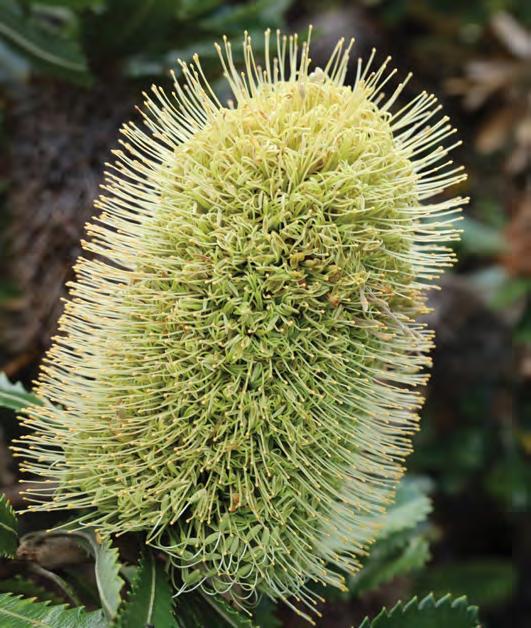
4 minute read
Saving the Eastern Suburbs Banksia Scrub
A group of passionate golfers and volunteer bushcarers are working with geneticists to determine why wallum banksia, Banksia aemula, is not growing in the critically endangered Eastern Suburbs Banksia Scrub, writes Chantelle Doyle, Restoration Genomics Outreach Coordinator.
Eastern Suburbs Banksia Scrub (ESBS) is a critically endangered ecological plant community restricted to the Sydney Basin. Due to land clearing, less than 3 per cent remains, restricted to small fragments in Council reserves, National Park estate and, importantly, private areas such as golf courses. In Sydney’s eastern suburbs one such golf club, Bonnie Doon, is undertaking dedicated restoration of critical ESBS remnants.
Advertisement
Led by Course Superintendent, Aaron Taylor assisting a passionate and dedicated volunteer Bushcare (and golfing) team, Bonnie Doon Golf Club has developed a plan to restore, regenerate and replant Eastern Suburbs Banksia Scrub. In doing so they are championing Sydney’s native vegetation and educating other players about the plant and animal biodiversity occurring on the course. Sue Baigent from Bonnie Doon Bushcare says the team have had considerable success with regenerating the area. “I just love being out here, seeing the dwarf tree frogs hiding in the lomandra, and the jacky dragons scurrying under the log piles we create,” she says. “But the biggest thrill is new plants coming back. We were so excited when the orchids emerged last year and this year, we had Persoonia seedlings, something we haven’t seen recruit naturally before.”
It isn’t all good news however, as Sue and the team have noticed some plant species are not recruiting or producing seedlings. “One of the plants we are really worried about is the wallum banksia or Banksia aemula,” she says.
Banksia, as the name implies, are characteristic of Eastern Suburbs Banksia Scrub, but on Bonnie Doon the wallum banksia, one of a few banksia species associated with ESBS, seems to be slowly dying with no seedlings to replace it. In a collaboration with the Research Centre for Ecosystem Resilience (ReCER) at the Botanic Gardens of Sydney, Bonnie Doon have been using genetics to help identify if inbreeding, caused by fragmentation of habitat, might be one of the causes.
Searching for a solution
Dr Marlien van der Merwe from ReCER, who led the program, says that when they heard about the problems Bonnie Doon were having, they wanted to help. “Many plants such as banksia need disturbance like fire to help seeds germinate, but this relies on the mother plants producing viable seed. If plants are too inbred or too closely related, this can limit seed quality,” she explains. Along with researchers Alix Laplaud and Saphira BloomQuinn, Marlien created a project to understand the genetic diversity of Banksia aemula, not just in Bonnie Doon, but also across ESBS remnants and all along the
DR MARLIEN VAN DER MERWE, SCIENTIFIC OFFICER AT RECER
New South Wales east coast. By looking at sections of DNA known to have different forms of the same gene (alleles), the team were able to identify genetic similarities and differences between the populations. They were also able to identify how closely related individual plants were to one other. And what they discovered didn’t initially surprise them.
“Banksia aemula occurs all along the east coast of New South Wales, as well as in Eastern Suburbs Banksia Scrub,” Marlien says. “We found strong evidence for a gene flow between populations all along the New South Wales coast. This isn’t surprising if you think that historically pollen was transported between overlapping populations, often by birds.”
Encouraging diversity through cross pollination
The evidence of historic geneflow is important because today, in fragmented landscapes, geneflow from pollinators is often missing and bush regenerators are only working with plants from the local neighbourhoods. When Alix, Saphira and Marlien looked at the local genetic diversity of Banksia aemula in ESBS remnants, they found mixed genetic health.
“Some Banksia populations were surprisingly still genetically diverse, which we measure by calculating the heterozygosity, that is how many different alleles or variants of the same gene occur in a population,” Marlien says. “But other fragments, such as the patches at Bonnie Doon, showed evidence of inbreeding.”
Inbreeding is evidenced through many plants having the same alleles of gene variants, meaning they are homozygous. In plant populations, just like animals, inbreeding can be detrimental, resulting in reduced reproduction or poor health of seeds and seedlings. This inbreeding might be the reason that wallum banksia has low reproduction and recruitment.
To test this theory, Marlien recommends pollinating the Bonnie Doon Banksia aemula with pollen from less related plants in nearby ESBS, such as along Malabar headland. If inbreeding is the cause of low seed production, then Club staff and the Bushcare team would expect to see much better seeds forming after cross pollination, or genetic mixing.
“The fact that we had a question and can be part of solving the problem is really getting the team interested and enthusiastic to do more,” Sue says. “These results are so exciting for us – we hope this work can be extended to other species across ESBS.”
The results found by Marlien and the ReCER team might only be related to one plant species, but they have far-reaching consequences. In urban, fragmented landscapes, it is difficult for natural processes to occur.
“If we want biodiversity to be retained, we will need to think of creative ways to help reinvigorate natural regeneration,” Marlien says. As a result of this pilot study, the ReCER team are planning a much larger study across other ESBS species.
In the past, a penchant for exotic plantings in golf courses meant their benefit for biodiversity was unrealised, but as pride increases in the ‘natural aesthetic’ and golf clubs around Australia begin to champion their local plant species, biodiversity will return. Sometimes it just takes a few passionate, persistent individuals to be part of driving the change.










